Click on images to enlarge
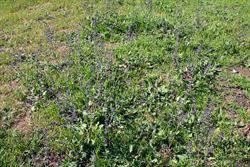
infestation (Photo: Sheldon Navie)
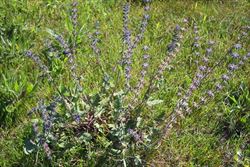
habit in flower (Photo: Sheldon Navie)
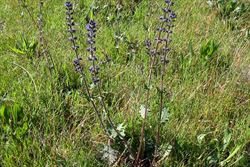
habit in flower (Photo: Sheldon Navie)
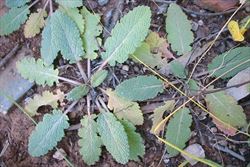
rosettes of lower leaves with toothed margins (Photo: Sheldon Navie)
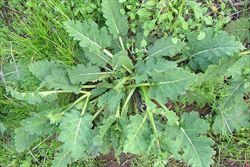
lower leaves with more deeply lobed margins (Photo: Sheldon Navie)
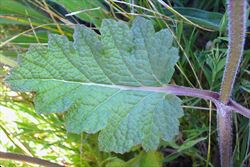
close-up of stem leaf (Photo: Sheldon Navie)
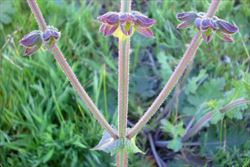
four-angled stems showing base of branched flower cluster (Photo: Sheldon Navie)
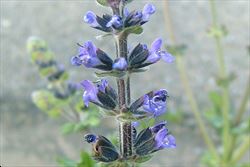
close-up of flowers (Photo: Sheldon Navie)
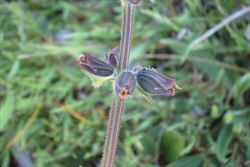
immature fruit (Photo: Sheldon Navie)

close-up of mature fruit (Photo: Sheldon Navie)
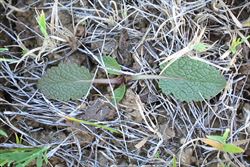
young plant (Photo: Sheldon Navie)
Scientific Name
Salvia verbenaca L.
Synonyms
Salvia clandestina L.Salvia horminoides Pourr.Salvia verbenaca L. var. verbenacaSalvia verbenaca L. var. vernalis Boiss.
Family
Labiatae (South Australia)Lamiaceae (Queensland, New South Wales, the ACT, Victoria, Tasmania, Western Australia and the Northern Territory)
Common Names
clary, clary sage, salvia, verbena sage, vervain sage, vervain salvia, wild clary, wild sage
Origin
Native to northern Africa, western and southern Europe, the middle-east and western Asia.
Naturalised Distribution
A very widely naturalised species that is most common in the southern parts of Australia. It is widespread in New South Wales, the ACT, Victoria, Tasmania, southern and eastern South Australia and southern Western Australia. Occasionally naturalised in southern and central Queensland, in the southern parts of the Northern Territory and in other parts of South Australia and naturalised on Norfolk Island.
Also naturalised in New Zealand and the USA (i.e. California, Alabama, Georgia, North Carolina, Virginia, Pennsylvania, Maryland and New Jersey).
Habitat
A common weed of pastures, grasslands, grassy woodlands, open forests, lawns, parks, footpaths, crops, roadsides, disturbed sites and waste areas in temperate and semi-arid regions. Occasionally also growing in sub-tropical and arid environments.
Habit
A long-lived (i.e. perennial) herbaceous plant growing up to 70 cm tall, but usually less than 50 cm in height. It forms a basal rosette of leaves during the early stages of growth and eventually produces one or more upright (i.e. erect) stems from a tough underground rootstock.
Distinguishing Features
- a long-lived herbaceous plant growing up to 70 cm tall, but usually less than 50 cm in height.
- it initially forms a basal rosette of leaves and eventually produces upright stems from a tough underground rootstock.
- its hairy stems are four-angled and the hairs on the upper parts of these stems are often sticky.
- its paired leaves (2.5-10 cm long) are quite variable in shape with irregularly toothed to lobed or deeply-divided margins.
- its tubular flowers (7-13 mm long) are borne in groups along elongated clusters at the tips of the branches.
- these purple, blue, or pink flowers are almost stalkless and separate into two lobes near their tips.
Stems and Leaves
The moderately to densely hairy stems are four-angled (i.e. quadrangular) in nature and the hairs on the upper parts of these stems are often sticky (i.e. glandular).
The leaves of this species are borne in pairs along the stems and are quite variable in shape. They range from oval (i.e. elliptic) to egg-shaped in outline (i.e. ovate) with irregularly toothed (i.e. crenate or serrate) margins to lobed or deeply-divided (i.e. pinnatifid or pinnatisect). The lower leaves (2.5-10 cm long and 1.5-8 cm wide) are borne on stalks (i.e. petioles) 1-10 cm long and have pointed or occasionally rounded tips (i.e. acute to rounded apices), while the upper leaves are smaller and stalkless (i.e. sessile). Leaves are also somewhat hairy (i.e. pubescent) with a pimply surface texture.
Flowers and Fruit
The tubular flowers (7-13 mm long) are borne in elongated clusters at the tips of the branches (i.e. in terminal racemes), which are often branched at the base. The flowers are arranged in groups of 6-10 (i.e. verticils) above small leafy bracts. Each flower is stalkless (i.e. sessile) or borne on a very short stalk (i.e. pedicel) up to 2 mm long. These flowers have five purplish or green sepals (3.5-9 mm long) that are moderately hairy. The sepals are fused together into a finely ribbed tube (i.e. calyx tube) which has a broad three-toothed upper lobe (i.e. upper lip) and a narrower two-toothed lower lobe (i.e. lower lip). The mostly hairless petals are also fused together at the base into a tube (i.e. corolla tube). They are blue, purple, pink or lilac in colour and also separate into two lobes (i.e. an upper and lower lip). The upper lip is hooded, while the lower lip is three-lobed. Each flower also has two stamens and an ovary topped with a style and unequally two-lobed stigma. Flowering occurs throughout the year.
The fruit (i.e. schizocarp) splits into four one-seeded segments (i.e. mericarps or nutlets) when mature. These brown 'seeds' (2-3 mm long and 1.8-2 mm wide) are broadly egg-shaped (i.e. broadly-ovoid) and smooth in texture.
Reproduction and Dispersal
This species reproduces via seed, which are dispersed by water and in mud adhering to animals, machinery and vehicles. They may also be dispersed in contaminated agricultural produce.
Environmental Impact
Wild sage (Salvia verbenaca) is regarded as a significant environmental weed in Victoria and as an environmental weed in South Australia, New South Wales, Queensland and Western Australia.
Legislation
Not declared or considered noxious by any state government authorities.
Similar Species
Wild sage (Salvia verbenaca) may occasionally be confused with mintweed (Salvia reflexa ). These two species can be distinguished from each other by the following differences:
- wild sage (Salvia verbenaca) has leaves with toothed (i.e. crenate) to deeply-lobed margins and their bases are broad (i.e. truncate) or heart-shaped (i.e. cordate). Its upper leaves are stalkless (i.e. sessile) and its flowers are dark purple, bluish-purple or lilac in colour.
- mintweed (Salvia reflexa) has leaves with almost entire margins and their bases taper to the leaf stalks (i.e. they are cuneate). All of its leaves are stalked (i.e. late) and its flowers are pale blue in colour.

